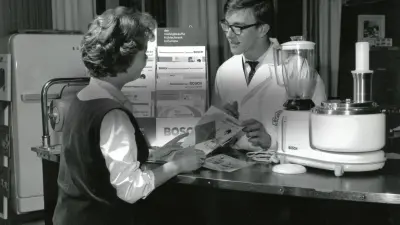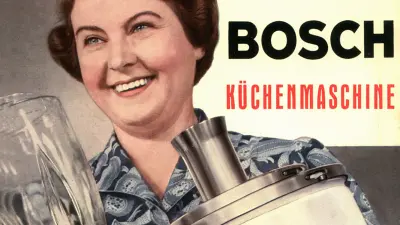Attractively designed allrounder
the Bosch kitchen machine

Swedish researchers in the early 1950s discovered something astonishing: Local housewives did more work than all the workers in the country’s iron and mining industry put together.
The Bosch kitchen machine
According to the results of the research, their daily intake of 3,700 calories to cope with various tasks was the same as that of a railway engine driver. Strenuous and perspiration-pushing activities were all part of the repertoire of every housewife. Mixing, kneading, chopping, slicing, passing vegetables through a sieve, making purées, grinding, grating... all for the physical welfare of the family.
Long-suffering housewife

At any rate, it was the long-suffering housewife who inspired Bosch engineers in 1952 to develop a piece of equipment that enormously eased the burden of household chores: the Bosch “New Age” kitchen machine. It effortlessly performed all the drudgery involved in food preparation, and the energy it required came exclusively from the wall socket.
The development department based this new product on Bosch power tools. “What was possible for tools used by men also had to be feasible for the tools used by women,” was the comment of the staff magazine “Bosch-Zünder” in 1953.
The design
A pear-shaped baseplate formed the basis. While the wider end of the baseplate provided space for a mixing bowl, the narrower end housed the 400-Watt-motor. The kitchen appliance could be unproblematically tilted sideways and, in this stable position, could mince large amounts of meat with the help of the mincer attachment. Further functions were performed by the mixer, the strainer, the coffee grinder, the cutting and grating disks as well as the mixing bowl with mixing arm.
In the design field, too, the new Bosch all-rounder hit the bulls-eye. At a special exhibition held on the occasion of the German Industrial Fair in 1956, the kitchen machine was given an award as an “attractively designed industrial product”.

“economic miracle”
The kitchen machine came with a booklet containing numerous recipes which, today, give us an interesting insight into the eating habits of the “economic miracle” generation. The deprivations of the war and the immediate post-war period apparently had to be compensated for by a large number of nutritious dishes.
Most of these dishes were improved by a home-made mayonnaise the ingredients of which could be blended in the mixer attachment in a fraction of the time normally required when using a whisk.

Same basic principle
Today’s Bosch kitchen machines are equipped with SensorControl Plus automatic programs and a powerful 1500-watt motor. The basic principle however is still the same – even though the recipe’s booklet doesn’t contain any mayonnaise dishes rich in calories but vitamin-packed fruit shakes.

Author: Christine Siegel
